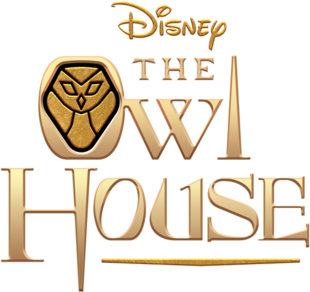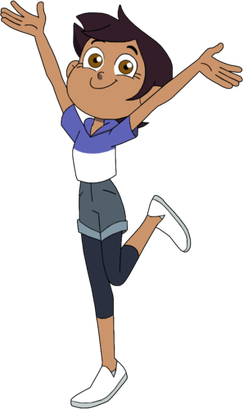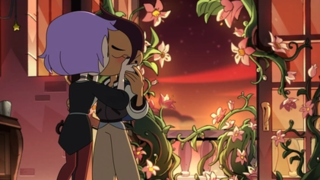
LGBT representation in children's television is representation of LGBT topics, themes, and people in television programming meant for children. LGBT representation in children's programming was often uncommon to non-existent for much of television's history up to the 2010s, but has significantly increased since then.
Historically, the portrayal of lesbian, gay, bisexual, and transgender (LGBT) people in media has been largely negative if not altogether absent, reflecting a general cultural intolerance of LGBT individuals; however, from the 1990s to present day, there has been an increase in the positive depictions of LGBT people, issues, and concerns within mainstream media in North America. The LGBT communities have taken an increasingly proactive stand in defining their own culture, with a primary goal of achieving an affirmative visibility in mainstream media. The positive portrayal or increased presence of the LGBT communities in media has served to increase acceptance and support for LGBT communities, establish LGBT communities as a norm, and provide information on the topic.

Queerbaiting is a marketing technique for fiction and entertainment in which creators hint at, but do not depict, same-sex romance or other LGBTQ+ representation. The purpose of this method is to attract ("bait") a queer or straight ally audience with the suggestion or possibility of relationships or characters that appeal to them, while not alienating homophobic members of the audience or censors by actually portraying queer relationships.

The portrayals of bisexuality in the media reflect societal attitudes towards bisexuality in the existing media portrayals. Throughout history, numerous bisexual characters have appeared in television series, including cartoons, anime, video games and web series, along with literature, comics, radio, and other mediums.

Molly Knox Ostertag is an American cartoonist and writer. Her work includes the animated series The Owl House, webcomic Strong Female Protagonist, the middle grade graphic novel series, and on the series Tales of the Night Watchman. She was named one of Forbes magazine's 30 Under 30 in 2021.

The Owl House is an American animated fantasy television series created by Dana Terrace that aired on Disney Channel from January 10, 2020, to April 8, 2023. The series features the voices of Sarah-Nicole Robles, Wendie Malick, Alex Hirsch, Tati Gabrielle, Issac Ryan Brown, Mae Whitman, Cissy Jones, Zeno Robinson, Matthew Rhys, Michaela Dietz, Elizabeth Grullon, and Fryda Wolff.

Dana Terrace is an American animator and voice actress, best known as the creator of the Disney Channel animated series The Owl House. She is also known for storyboarding on Gravity Falls and directing on the 2017 reboot of DuckTales.
For many years, LGBT representation increased on animated series and animated films. In the 1990s, LGBT characters were depicted in animated series like South Park, The Ambiguously Gay Duo, and The Simpsons. In the early 2000s, LGBT representation increased in Western animation, culminating in GLAAD's "Where We Are in TV" report in 2005, even as representation in such animation was scattered and disparate. In the 2000s, series like Queer Duck, The Oblongs, The Venture Bros., Drawn Together, and Archer would air. It would not be until the advent of shows like Steven Universe, The Legend of Korra, and Adventure Time in the 2010s, that LGBT characters in animation would gain more of a prominent role, leading to shows such as She-Ra and the Princesses of Power in 2018 and Kipo and the Age of Wonderbeasts in 2020, along with other series in the 2020s. This page will show this progress by building off the lists of animated series which contain these characters and explain the History of LGBT characters in animation. It does not focus on LGBT characters in anime series or films, which is examined on the LGBT themes in anime and manga page.
In the 1990s, more LGBTQ characters began to be depicted in animated series than in any of the years before. The depiction of LGBTQ characters changed significantly compared to previous decades. Some of the most prominent Western animated series during this decade which featured LGBTQ characters were South Park, King of the Hill, Futurama, and The Ambiguously Gay Duo. The representation in 1990s series would also influence series in the 2000s.

Luz Noceda is the protagonist of the Disney Channel animated series The Owl House, created by Dana Terrace. She is voiced by Sarah-Nicole Robles.
In the 2020s, LGBTQ representation in animated series and animated films became more pronounced than it had in the 2010s, or 2000s when it came to Western animation. This included series like The Owl House, Harley Quinn, Adventure Time: Distant Lands, RWBY, and Dead End: Paranormal Park. Series like She-Ra and the Princesses of Power, Steven Universe Future, The Hollow, and Kipo and the Age of Wonderbeasts, which had various LGBTQ characters, came to an end in 2020, and Gen:Lock came to an end in 2021. An upcoming season of Hazbin Hotel was hinted at, while an animated adaption of Lumberjanes was in development.
This article features the history of the representation of lesbian, gay, bisexual, and transgender (LGBT) characters in animated productions under The Walt Disney Company, including films from the studios Walt Disney Animation Studios and Pixar, and programming from the Disney Branded Television channels as well as the streaming service Disney+. From 1983 onward, Disney struggled with LGBTQ representation in their animated series, and their content often included LGBT stereotypes or the content was censored in series such as Blazing Dragons. Some creators have also criticized Disney studio executives of cutting LGBTQ scenes from their shows in the past, or criticized that their shows were not seen as part of the "Disney brand", like The Owl House.

"Thanks to Them" is the season three premiere of the American animated television series The Owl House, and the 41st overall episode of the series. The episode was written by show creator Dana Terrace, Luz Batista, and Emmy Cicierega, and directed by Bosook Coburn and Amelia Lorenz. It originally aired on October 15, 2022 on both Disney Channel and Disney XD, and was released on the former channel's official YouTube channel and Disney+ afterwards.

"Clouds on the Horizon" is the 20th and penultimate episode of the second season of the American animated television series The Owl House. In the episode, the Covens Against the Throne try to find a way to stop the Day of Unity, which would essentially kill all life on the Boiling Isles. The plan follows Eda Clawthorne taking over Raine Whispers' place as Bard Coven Head, while Luz and her friends try to stop Abomaton production.

Amity Blight is a fictional character in the Disney Channel series The Owl House. She is voiced by Mae Whitman.

"Watching and Dreaming" is the series finale of the American animated television series The Owl House. The episode served as the third and final episode of the third season, and the 43rd episode of the series overall. In the episode, Luz, after reuniting with Eda and King, manages to befriend the Collector and stop Belos from destroying the Boiling Isles.












